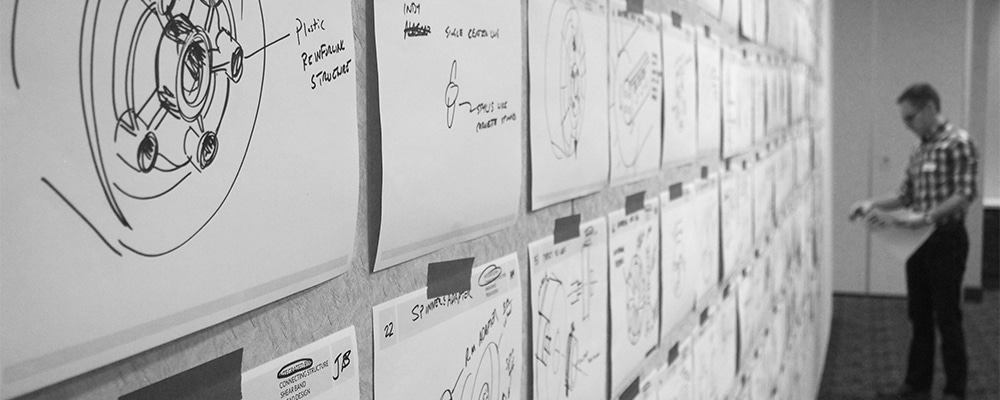Some believe that artistic skill and uber-creativity are required prerequisites for brainstorming activities. That could not be farther from the truth.
The true magic that Catalyst Product Design and Development provides lies in our collaborative innovation process. Because Catalyst is both a design consultancy and a tooling and plastic molding company, we understand the concerns that cross-functional teams have when it comes to innovation and developing new products.
OVERCOMING SILOS AND GAINING EARLY BUY-IN
Many of our larger clients have armies of designers, engineers, and manufacturing associates at their disposal. The issue is not usually a lack of creativity or even a lack of resources in generating creative solutions, it is overcoming the silos that are created between departments. Usually the walls that are created between departments are not intentional—it just happens when companies reach a certain size. Agility, communication, speed all begin to suffer as tasks become compartmentalized. The key to overcoming this is getting buy-in from everyone on the project team early in the process. Moreover, not when a concept is chosen by management— buy-in has to happen even earlier. We have found that by allowing the entire project team to share in the innovation process, everyone takes ownership—even if the final concept direction was not their idea, everyone feels like it was.

We recently had a client from the food processing industry come to us with a need. Historically, they used metal castings and wanted help changing some components to plastic. They had an industrial designer on staff and had recently hired a plastics engineer so they had the resources in place, but they were struggling to overcome a cultural issue: they had always used metal castings and many team members did not understand why plastics were needed. The CEO of the company reached out to us and we suggested a rapid ideation session–a rapid-fire brainstorming method developed by Catalyst. We also suggested they bring as large a team possible–and, they did.
They brought their entire engineering, manufacturing, and quality staff plus their financial officer, the HR manager, and a number of associates from the manufacturing area. Normally, we will use a game or ice-breaking exercise to make everyone comfortable and a brief discussion of the challenge or opportunity. But when we bring out the stacks of sketch paper and the buckets of Sharpies, the first thing we usually hear is…

I can’t draw.
I get it— My drawings look like pictures Kindergarteners bring home that parents are afraid to guess what they are (“Oh it’s a big, scary dinosaur” “No daddy, it’s you!”).
It is difficult not to be impressed or intimidated by people who can draw something that actually looks like the thing they were drawing. But, I am here to tell you that while sketching is very critical to capturing concepts during brainstorming, the quality required of it, is not. If it looks like a big scary dinosaur but still illustrates an idea, mission accomplished.
THE IMPORTANCE OF BRAINSTORMING AND IDEATION
Brainstorming and ideation sessions are about generating ideas not artwork. In fact, some of the best concepts often come from those who are not usually involved in direct product design or development. Not knowing what one doesn’t know is a huge benefit as it reduces preconceived ideas and allows for pure blue sky thinking.
It is an interesting dynamic to see associates interact together for a creative exercise. At first, no one wants to say anything, but then as concepts or ideas are discussed, everyone begins to open up. I always find the most interesting aspect of multi-disciplinary brainstorming activities is when they start from a slow burn and build to an explosion of ideas– and this one was no different. Once the creative frenzy started, no one was worrying about what their sketches looked like as long as intellectual property was captured. By the end of the day, the group had generated over 500 potential concepts.
From small entrepreneurial start-ups to Fortune 100 companies, Catalyst partners with teams of all sizes to help create award-winning industrial design. Furthermore, the designs are reality-based which means the product will be able to be produced quickly and cost-effectively. Contact the Catalyst team on our website or by phone at 866-275-2757 to find out how your team could be a part of a collaborative brainstorm.
